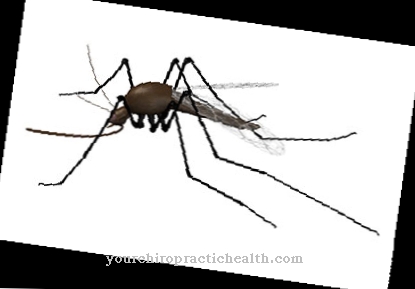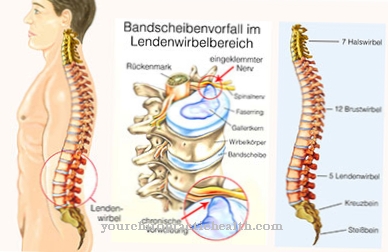Cortical blindness is the older term from neurology that describes an acquired blindness that is not due to a diseased eye, but to damage to the primary visual cortex in the brain. Frequently used synonyms are blind vision and Blindside. American medical professionals coined the latter term.
What is cortical blindness?

© mrhighsky - stock.adobe.com
People with cortical blindness have fully functioning eyes. Only the primary visual cortex in the cortex of the brain is damaged. The most common cause of this damage is a stroke. However, the description of this disease using the terms "blind vision" is not entirely correct. Cortical blindness prevents visual impressions from reaching the primary visual cortex in the brain, which enables a conscious perception of the environment.
The term “blind vision” is a popular paraphrase for people who are blind but behave as if they can see. In cortical blindness, the various nerve tracts above the eye remain intact. They are responsible for transmitting incoming optical stimuli to the brain. If the primary visual cortex is damaged, however, these optical stimuli are not transmitted and humans are unable to consciously perceive their environment. The medical specialties are neurology and ophthalmology.
causes
It is a cortical amaurosis, which is associated with the loss of optical perception with simultaneously extensive processes in the visual cortex. However, the pupil responses do not change. There is a bilateral loss of function of the primary visual cortex in the posterior flap. Other causes are tumors, an ischemic cerebral infarction of the arteriae cerebri posteriores (insufficient blood supply to the cerebral artery) and all types of severe head injuries, for example a fracture of the base of the skull after an accident.
These patients no longer see their environment consciously, but show visual reflexes. In the back of the head is the visual cortex, the primary visual cortex, which is responsible for combining incoming optical signals into a consciously perceived image. This visual cortex is, so to speak, the data center of the human sense of sight. Patients with cortical blindness actually see something, they just do not know it because the transmission of the visually perceived stimuli via the primary visual cortex into the consciousness does not take place.
Symptoms, ailments & signs
The cortical blindness and the closely related soul blindness belong to the medical field of agnosia. This term comes from the Greek language and means "not knowing". Soul blindness differs from cortical blindness in that objects are perceived, but can no longer be assigned.
Sigmund Freud assigned both visual disorders to agnosia. With cortical blindness there are no attention disorders, sensory defects or cognitive disorders. The visual apparatus consists of the eye, the visual center and the optic nerves of the cerebral cortex. In cortical blindness, the functionality of the visual cortex fails completely. In the legal sense, a person with this disease is considered to be blind even though the eyes are not damaged.
Diagnosis & course of disease
The main symptoms are visual field defects in the temple area (temporal) or in the nose area and the subsequent loss of optical perception. A crossed equilateral (homonymous) hemianopia is typical of this type of disease. If there is a left-sided lesion of the visual cortex, the right halves of the face fall out and vice versa. If the end of the tract or the corpus geniculatum (medial knee cusp in the largest part of the diencephalon) are affected, the hemianopia is complete in many cases, otherwise incongruent and incomplete.
The corresponding nerve fibers have not yet been completely assembled. Some patients have more or less bilateral optic atrophy (degenerative disease of the optic nerve). The diagnosis is mainly made in experiments with flashes of light that cortical blind people do not consciously perceive, but can intuitively determine from which direction they are coming. However, you are unable to say why this is so.
Neurologists suspect that the people affected perceive the flashes of light in the subconscious. Since medicine has not yet been able to conclusively determine how this process actually works, scientists have also carried out experiments with healthy people. In these test series, the test subjects' visual center was blocked by means of transcranial magnetic stimulation (TMS). These tested people were also not aware of the flashes of light, but were also able to name the direction.
They could intuitively name colors that were presented to them correctly. The tests showed that they were not consciously aware of the lightning bolts and the colors, as they denied having seen anything at all. The same injuries or diseases of the brain can be found in all persons with cortical blindness. Further findings are made on the basis of the neurological and ophthalmological picture as well as the evaluation of magnetic resonance tomography or computer tomography.
Complications
Cortical blindness can develop as a complication after a stroke, after bleeding in the visual cortex, after brain tumors or a traumatic brain injury. As part of these diseases, the visual cortex is sometimes destroyed, which can lead to blindness.
The pictures are taken by the normally functioning eyes. However, due to the damage to the bark, they can no longer be processed and made conscious. Serious complications that lead to life-threatening courses are not caused by cortical blindness. These are then complications of the underlying disease.
As the damaged cortex cannot be regenerated, curative treatment of cortical blindness is not possible. As a direct consequence of cortical blindness, the risk of suffering an accident can increase. This danger is particularly pronounced with a special form of cortical blindness in which the patient has no insight into the disease. This is the very rare antonym syndrome.
Patients with antonym syndrome cannot tell that they cannot see anything. The first challenge facing the treating physician is to convince those affected that they are blind in order to avoid exposing themselves to the risk of an accident. Persuasion is often very difficult and can only be achieved with the help of a combination of physiotherapy, psychotherapy and occupational therapy.
When should you go to the doctor?
Cortical blindness is a serious condition that requires medical attention. If vision is impaired after a stroke or other medical emergency, the doctor must be informed. Further visits to the doctor are indicated if the eyesight deteriorates even though treatment measures have already been taken. Then there may be other disorders that are best clarified promptly. If the treatment is given early, the chances of recovery are relatively good. In the absence of treatment, the visual disturbances can worsen. In the worst case scenario, complete blindness occurs in one or both eyes. Therefore, an early diagnosis is important in any case.
Cortical blindness is treated by a neurologist or ophthalmologist. The actual therapy takes place in a specialist center for visual disorders, in which NEC, VRT and other vision therapies are offered. Close medical supervision is required during treatment. The doctor should be informed of any unusual symptoms and any side effects of the treatment so that the therapy can be adjusted accordingly.
Therapy & Treatment
The results of the investigations show that awareness is generated within the visual cortex and that information processing takes place even without conscious perception. For this reason, the patients examined are able to tell intuitively from which direction the flashes of light are coming or to correctly name the colors presented. Further studies show that people with a lesion of the visual cortex that have led to hemianoposia (unilaterally limited visual field loss) perceive emotional content on faces.
These are presented in the field of view that is no longer consciously perceived. This process occurs through the activation of visual centers in the superior colliculus (four-hill plate of the midbrain). The unconscious perception is projected onto the limbic system, especially onto the amygdala (paired core area of the brain of the medial part of the respective temporal lobe), which is important for the perception and processing of emotions.
Since the prognosis is usually that visual field defects do not regress, the therapy is causally oriented. Stroke patients receive extensive physiotherapy and speech therapy, while tumor patients primarily receive radiation therapy. In the case of skull and brain injuries, various rehabilitation measures are carried out in addition to the surgical intervention.
Aftercare
The cortical blindness does not meet the usual criteria of being blind. It is not innate, but is caused by damage in the responsible brain area. The eyes themselves remain functional. In addition, those affected by cortical blindness are not (always) completely visually impaired, they can only see outlines or shadows.
Blindness sets in with certain sensory impressions that are not correctly processed by the brain. This new situation is unfamiliar and stressful for patients. Follow-up care is necessary to learn how to deal appropriately with cortical blindness. Follow-up care takes place in both a neurological and an ophthalmological setting.The extent to which cortical blindness can be treated depends on the underlying disease.
In some patients, the ability to see is fully restored after the treatment has been completed, in other cases the visual impairment remains. Aftercare includes exercises for the eyes and for sensory processing. At the same time, the person concerned learns to cope with cortical blindness in everyday life.
Depending on the degree of blindness, aids such as white canes are useful. If the illness causes additional emotional stress, psychotherapy should be considered. Attending self-help groups for support can also have a positive effect on the quality of life of the person concerned.
You can find your medication here
➔ Medicines against memory disorders and forgetfulnessYou can do that yourself
Cortical blindness needs to be treated depending on the cause. A congenital disease significantly limits the children affected, who need permanent support in the first few years of life. The legal guardians should seek placement in a special kindergarten and later in a special school at an early stage.
Depending on the severity of the cortical blindness, the lack of vision can be compensated for with glasses or other visual aids. Which measures are sensible must be decided by a doctor depending on the severity of the suffering. Acquired cortical blindness, for example after a stroke, requires regular training. Physiotherapy and speech therapy are important components of therapy. Cancer patients who have developed cortical blindness should initially take it easy. The symptoms mostly disappear with radiation therapy. If this is not the case, a visual aid must be worn. In individual cases, eye surgery is possible.
If the cortical blindness is due to an injury to the skull or the brain, physiotherapy measures are indicated. The patient should contact a specialist and, moreover, independently perform exercises to restore neurological abilities.



























